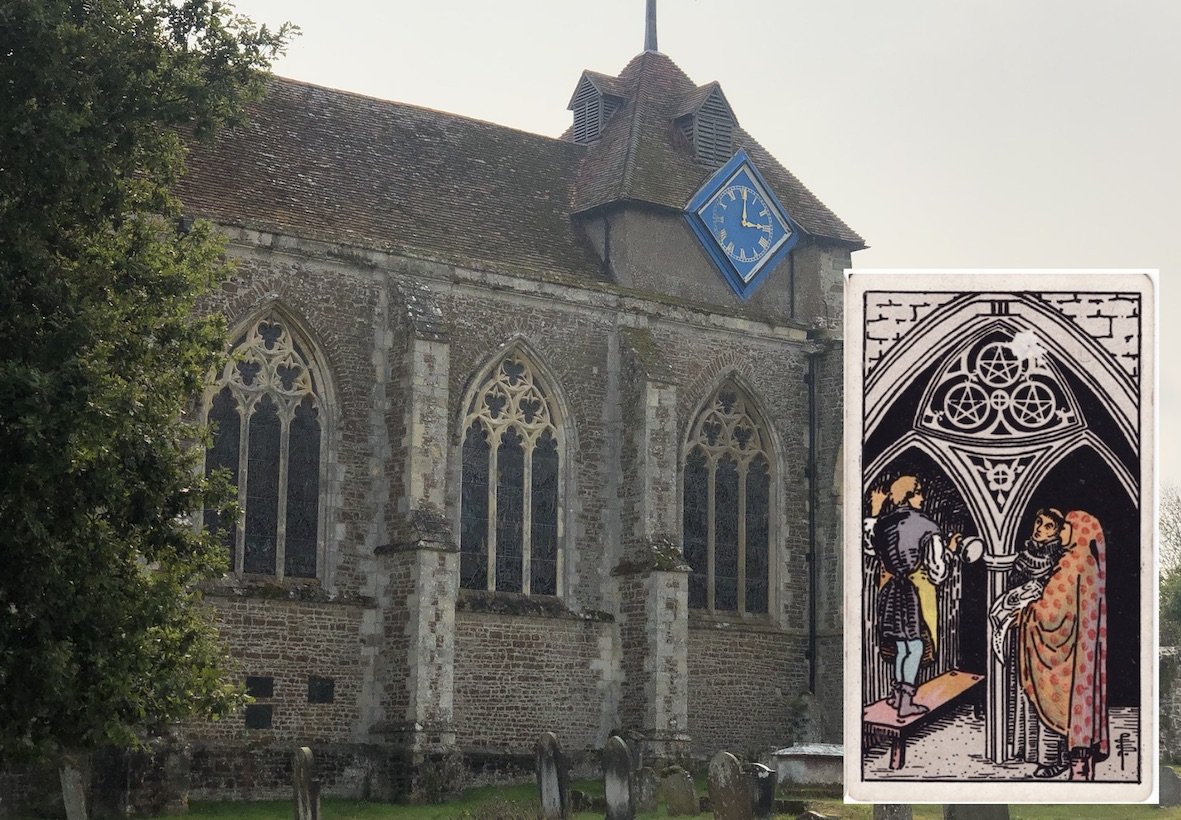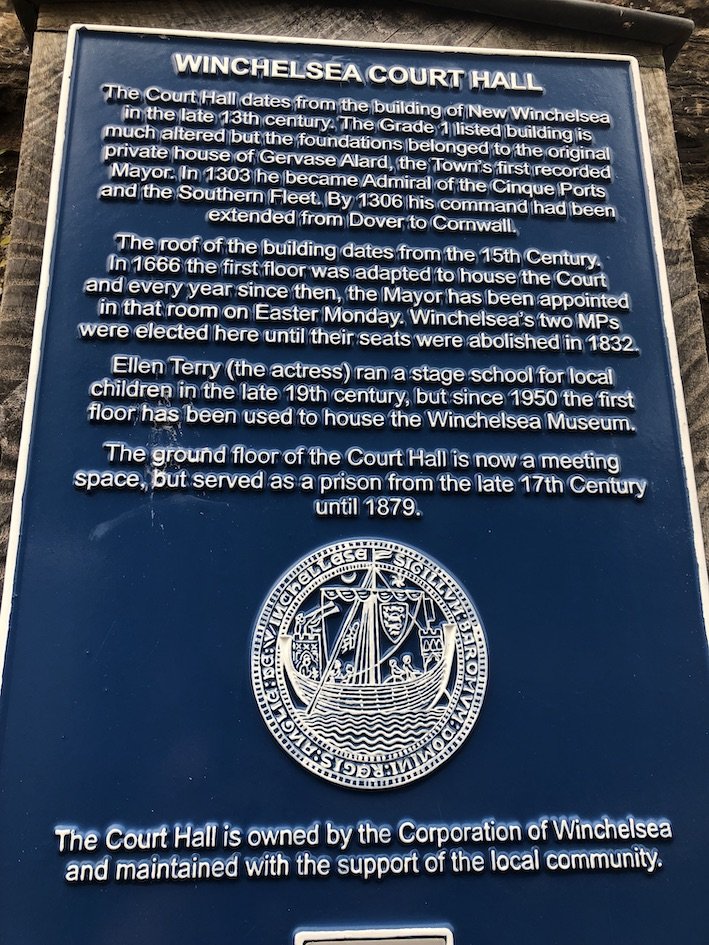Winchelsea and the Art of the Tarot
The Rider Waite Smith deck is the most iconic of tarot decks, and something of a gateway into the world of magic and the Devil's Uno. The artist Pamela Colman Smith was living in the small town of Winchelsea in East Sussex while painting the images, and much of the iconography was drawn from the world around her. Tower Cottage where she lived, for example, and the tower next door both feature on the 10 of Pentacles - a correspondence that is entirely appropriate for the card which alludes to the most concretised aspect of the suit of earth, the bricks of your house. The wall of the garden features in the Sun card, and the placement of the sun in the card is right where it would have risen as seen from over the road.
Tower Cottage and the Ten of Pentacles
The Sun and the wall of Tower Cottage
Last week I organised a trip to Winchelsea to explore the connections between the deck and the landscape, guided by local art historian Harriet Onslow Delaney of the Tadhg Mae Project in Hastings Old Town. Some of the history is documented in Marcus Katz's "Secrets of the Waite-Smith Tarot", such as the tomb effigy that found its way into the Four of Swords, but much is undocumented despite over 100 million RWS decks having being sold since 1909, and some of what we found may have gone completely unnoticed. The images are rarely direct copies of buildings and features of the town, but the influence on the artist’s work is clear.
The Four of Swords and a tomb effigy
Strength and a lion from the tomb effigy
The Heroic Dead of Winchelsea
Winchelsea has a strange pull to it. My first visit was by mistake, because the previous station had a short platform and my twins and I ran too slowly down the train to get out in time - but then a strange thing happened. My daughters, who were 14 at the time, looked out over the fields by the station and immediately fell in love with the place, asking if they could come back for a picnic. I thought it was quaint and picturesque enough, but from the station you can't see much more than a few fields; I was more impressed by how strongly they felt about the place than the place itself. Some weeks later they packed rice balls and took their first solo (duo) train ride, and only when a friendly local asked them what they were doing there did they discover the spectacular church, with its ruin and the grave of Spike Milligan, the beautiful cottages and landscapes. The town museum tells the story of how the town was rebuilt at its current site at the end of the 13th century as Old Winchelsea succumbed to coastal erosion.
Three of Pentacles and St. Michael's Church
The tarot connection was news to me, though I have studied tarot since my early twenties. For one thing I tend to use and teach from the Thoth deck, but it turns out that there is a Winchelsea connection with that deck too as its artist Lady Frieda Harris also spent time there in the same period. The RWS is a little more approachable than the Thoth deck, as one might expect given that its designer Arthur Waite was a manager of Horlick's (whereas the Thoth deck was designed by the notorious Aleister Crowley). The town should be a Mecca for tarot readers but there is very little mentioned in the museum and Tower Cottage doesn't even have a plaque to honour its resident whose impact on the world is hard to overstate. I like to think that my daughters, who have been pickled in witchcraft since before they were born, were drawn to the heroic ghosts of this sleepy little town without any of us knowing why.
Weird Hastings
Fast forward a few years to a project called Weird Hastings, which began as a publicity film for the local bureau of tourism but quickly morphed into a psychogeographical hypersigil and romp through the abundant weirdness of the area. Crowley famously died in Hastings, having spent some years growing up here and attending a school in the neighbourhood I used to live in (they say he cursed his schoolmaster and others who suffered misfortune immediately afterwards, but they also say he cursed the whole town of Hastings and that's clearly nonsense). Other local mystics had a similarly profound influence on the 20th century, such as Jesuit Teilhard de Chardin who developed his idea of the noosphere, or collective sphere of thought, informed by what he found in the fossil record at Pett Level just down the coast. John Logie Baird, the inventor of television, lived three minutes from my flat and conducted some of the experiments at his home; according to this Spiritualist inventor he was helped by Thomas Edison who advised him from beyond the grave.
There is also a superbly magical spring in St. Helen's Wood, rediscovered after being buried and forgotten for generations by a man wandering around the forest on acid wrestling with suicidal urges, and as he cleared the debris and revealed the ancient brickwork of the well his son recovered from an intractable lung condition. That story was told to me by someone who attended a hypno-magic workshop I was running at the White Rock Hotel, and he then told me another story of a woman digging cursed glass out of the ground of an Amazonian community after being guided to the site in a dream. He had heard this remarkable story at Occupy London, but more remarkable still was that he must have heard it from me when I was living there 12 years earlier since it was my ex-wife who did the digging, though neither of us could remember meeting (more on that story here).
That guy was brought along to the session by Michael Smith, director of the Weird Hastings film, and that was just one of the elements of high weirdness that attended that day. Things got weirder at every step and soon enough he and I were doing hypnotic spirit evocation in Hastings Museum before I was dressed up as the magician of the RWS deck and snapped by the photographer of Le Monde.
This was a surprise
There was another shoot straight after mine, capturing the High Priestess as incarnated into the body of Harriet, and during the brief chat we had I learned that she had been on the trail of Pamela Colman Smith in Winchelsea, so we decided to organise a trip together. Harriet printed out a map and came along with her husband and their chihuahua Akhenaten to meet a few tarot and pyschogeography geeks at Spike Milligan's grave outside St. Thomas's Church. We paid our respects by reciting a series of ludicrous poems, and then she lead us into the church to search for imagery of the cards in the masonry and the stained glass windows. We also visited some other places found in the cards, and finished our tour at the beacon looking over a landscape that would be familiar to anyone who knows the deck.
The Two of Cups and the view from the beacon
The town is rich with RWS imagery and we're only just scratching the surface but there's plenty more to be discovered. Marcus Katz' work in this area is impressive but we came up with an alternative suggestion for the inspiration for the building in the background of the Six of Cups. Katz proposed that it is based on Smallhythe Palace but it looks more like the Winchelsea court house, and there are several reasons why this seems more likely story.
The Six of Cups and the court house
Plaque on the court house
For one thing, the Six of Cups is a perfect card to represent the enjoyment of having cheery drinks with your friends, and the court house is directly opposite the only pub in town - the New Inn with a charming beer garden where our group stopped to look through antique decks and do some divination together. The other reason is that Ellen Terry ran a stage school there according to the plaque on the wall, and that the card depicts a rather theatrical scene of children playing as adults. Terry was the woman who brought Smith to Winchelsea in the first place, and the owner of Tower Cottage. Their friendship was clearly very close; the Queen of Wands features Terry's daughter Edith Craig and her cat Snuffles.
The magical and art history of Winchelsea is deep and fascinating, and we'll be mining this seam for a while yet. If you'd like to join a trip to uncover more secrets, to throw some cards at the birthplace of the deck and do some path-working in the landscapes featured in its backgrounds, get in touch so we can let you know when we're planning our next visit.














